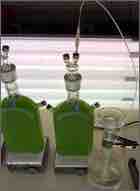Four Stages of Anaerobic Digestion
Acidogenesis is the second stage in the four stages of anaerobic digestion: hydrolysis, acidogenesis, acetogenesis, and methanogenesis. Hydrolysis is a chemical reaction wherein particulates are solubilized and large polymers are converted into simpler monomers. Acidogenesis is a biological reaction wherein simple monomers are converted into volatile fatty acids. Acetogenes is a biological reaction wherein volatile fatty acids are converted into acetic acid, carbon dioxide, and hydrogen . Finally, methanogenesis is a biological reaction wherein acetates are converted into methane and carbon dioxide, and hydrogen is consumed.

Biofuel production can come from plants, algae, and bacteria.
Biohydrogen is defined as hydrogen produced biologically, most commonly by algae, bacteria, and archaea. Species of the Clostridium genus allow hydrogen production, a potential biofuel, in mixed cultures.
Anaerobic digestion is a complex biochemical process of mediated reactions undertaken by a consortium of microorganisms to convert organic compounds into methane and carbon dioxide. It is a stabilization process, reducing odor, pathogens, and mass reduction. Hydrolytic bacteria form a variety of reduced end-products from the fermentation of a given substrate.
One fundamental question in anaerobic digestion concerns the metabolic features that control carbon and electron flow. This flow is directed toward a reduced end-product during pure culture and mixed methanogenic cultures of hydrolytic bacteria. Thermoanaerobium brockii is a representative thermophilic, hydrolytic bacterium, which ferments glucose, via the Embden–Meyerhof Parnas Pathway.
Acidogenisis
Acidogenic activity was found in the early 20th century, but it was not until mid-1960s that the engineering of phases separation was assumed in order to improve the stability and waste digester treatment. In this phase, complex molecules (carbohydrates, lipids, and proteins) are depolymerized into soluble compounds by hydrolytic enzymes (cellulases, hemicellulases, amylases, lipases and proteases). The hydrolyzed compounds are fermented into volatile fatty acids (acetate, propionate, butyrate, and lactate), neutral compounds (ethanol, methanol), ammonia, hydrogen and carbon dioxide. Acetogenesis is one of the main reactions of this stage. In this reaction, the intermediary metabolites produced are metabolized to acetate, hydrogen, and carbonic gas by the three main groups of bacteria—homoacetogens, syntrophes, and sulphoreductors. For the acetic acid production are considered three kind of bacteria: Clostridium aceticum, Acetobacter woodii, and Clostridium termoautotrophicum.
In 1979, Winter and Wolfe demonstrated that A. wodii in syntrophic association with Methanosarcina produce methane and carbon dioxide from fructose, instead of three molecules of acetate. C. thermoaceticum and C. formiaceticum are able to reduce the carbonic gas to acetate, but they do not have hydrogenases to inhabilite the hydrogen use, so they can produce three molecules of acetate from fructose. Acetic acid is equally a co-metabolite of the organic substrates' fermentation (sugars, glycerol, lactic acid, etc.) by diverse groups of microorganisms, which produce different acids:
- propionic bacteria (propionate + acetate)
- Clostridium (butyrate + acetate)
- Enterobacteria (acetate + lactate)
- Hetero-fermentative bacteria (acetate, propionate, butyrate, valerate, etc.)